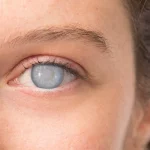What is Charles Bonnet syndrome?
Charles Bonnet syndrome is a condition where visual hallucinations are experienced by people who don’t have a mental health issue. These hallucinations are sometimes called ‘phantom images’.
Most people who have Charles Bonnet syndrome have very poor vision, but it can also affect people who have only slight loss of vision.
The condition can affect people of any age, but it’s more likely to occur if you have significant vision loss later in life. You can have Charles Bonnet syndrome if you have macular degeneration, diabetic retinopathy or glaucoma.
Experts do not know what causes these images, but some think the brain invents fantasy pictures or releases old pictures that are stored there to compensate for not receiving images through the eyes.
What are the symptoms of Charles Bonnet syndrome?
It’s common to see geometric patterns and lines with Charles Bonnet syndrome. Complicated images of people and places are common too. People with the condition report seeing pictures of animals, plants, buildings, day-to-day objects and even entire landscapes.
Images can be beautiful, funny, strange or disturbing. They might float in the air, or appear on a wall or ceiling. They might be moving or still. They could be colourful or just black and white.
Most people who experience this syndrome know these images are not real.
Phantom images can be experienced for a few days or for many years. They can come and go, lasting for just a few seconds or continuing for many hours.
If you have Charles Bonnet syndrome, you do not have a mental problem; rather, you have a problem with your vision.
Talk to your doctor, an ophthalmologist, or a healthcare worker if you start seeing phantom images. They might not have heard about the condition, so you may have to tell them about it.
How is Charles Bonnet syndrome diagnosed?
Diagnosing Charles Bonnet syndrome will involve taking a comprehensive medical history and an eye examination as a minimum. It may also involve a physical examination and tests for other causes of hallucinations.
About 1 in 3 people with significant vision loss may experience phantom visions, but many people with Charles Bonnet syndrome never tell anyone about their symptoms and so they never get a diagnosis. They worry that people might think they are insane, or their doctor might not take them seriously.
You might be diagnosed with Charles Bonnet syndrome if you:
- have seen a complex visual hallucination recently
- know what you saw was not real
- are not mentally ill
- do not have hallucinations involving other senses, such as your hearing
Living with Charles Bonnet syndrome
There is no single treatment for Charles Bonnet syndrome, although in many cases some reassurance may be enough to help you. Realising that Charles Bonnet syndrome is not a mental health issue may help you live with it.
It can also help to know that for most people, the hallucinations stop within 12 to 18 months.
If you experience more disturbing images, to help manage the symptoms you could consider the following:
- Visit your eye specialist so they can monitor your vision, prescribe the right spectacles and remove any cataracts.
- Improve your lighting at home, reduce any glare and use a magnifier for close work. These simple changes have helped some people. Contact your local low-vision rehabilitation service provider for assistance.
- Stimulate the brain and senses since this may reduce the likelihood of symptoms. Activities such as listening to a talking book, exercising — even doing some gardening — may help.
- Socialise more or join a support group. Social isolation has been shown to increase the likelihood of experiencing phantom images.
- Where possible, reduce stress and anxiety — for example through a hobby or creative activity — since stress tends to make the condition worse. Phantom images can become more intense and occur more often when you are stressed.
- Talk to your doctor about medicines or electromagnetic stimulation. (This relatively new treatment increases or decreases brain cell activity depending on the symptoms being experienced).
Can Charles Bonnet syndrome be prevented?
It’s not certain why some people experience phantom images but others don’t.
You cannot prevent Charles Bonnet syndrome from developing, but you may notice a pattern of triggers that help you manage the condition. Poor lighting, early mornings, late afternoons, nighttime, being at home and being tired can all be triggers. If you notice a pattern, you may be able to do something about it.




